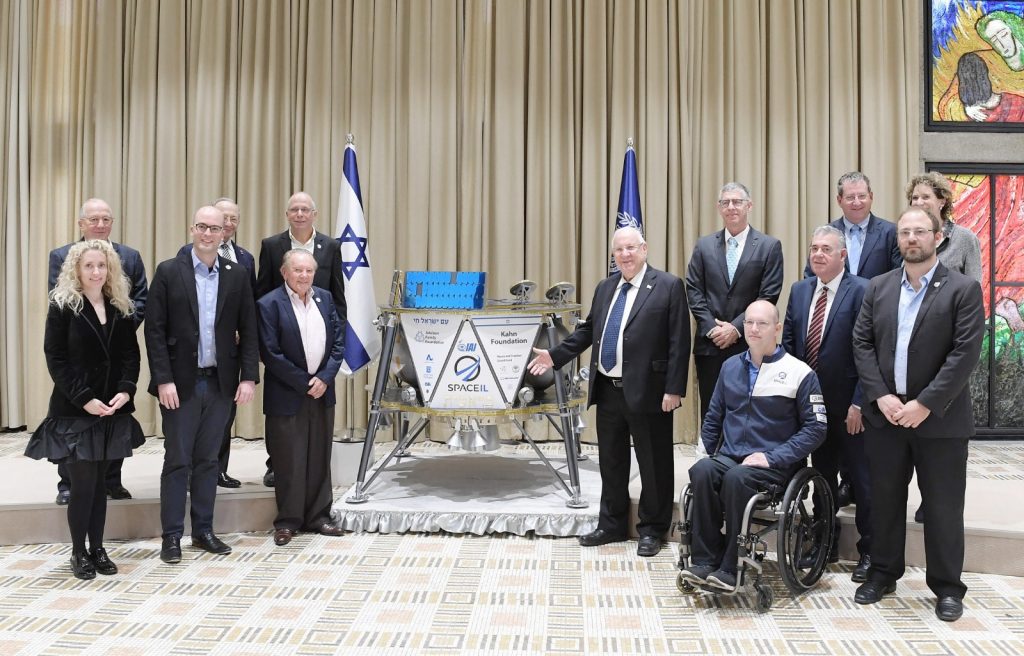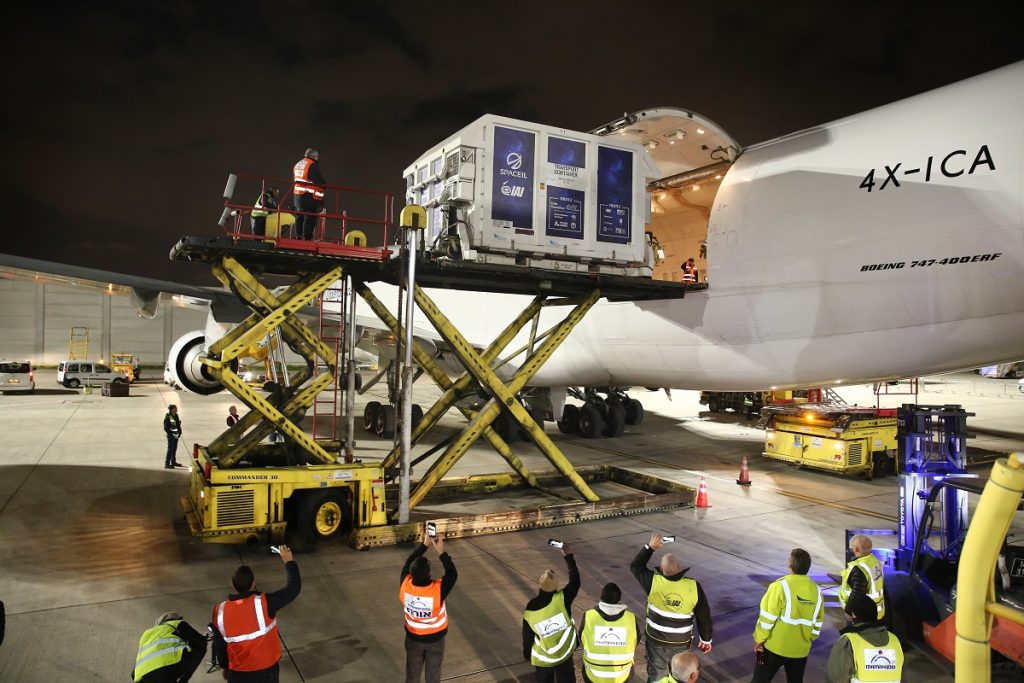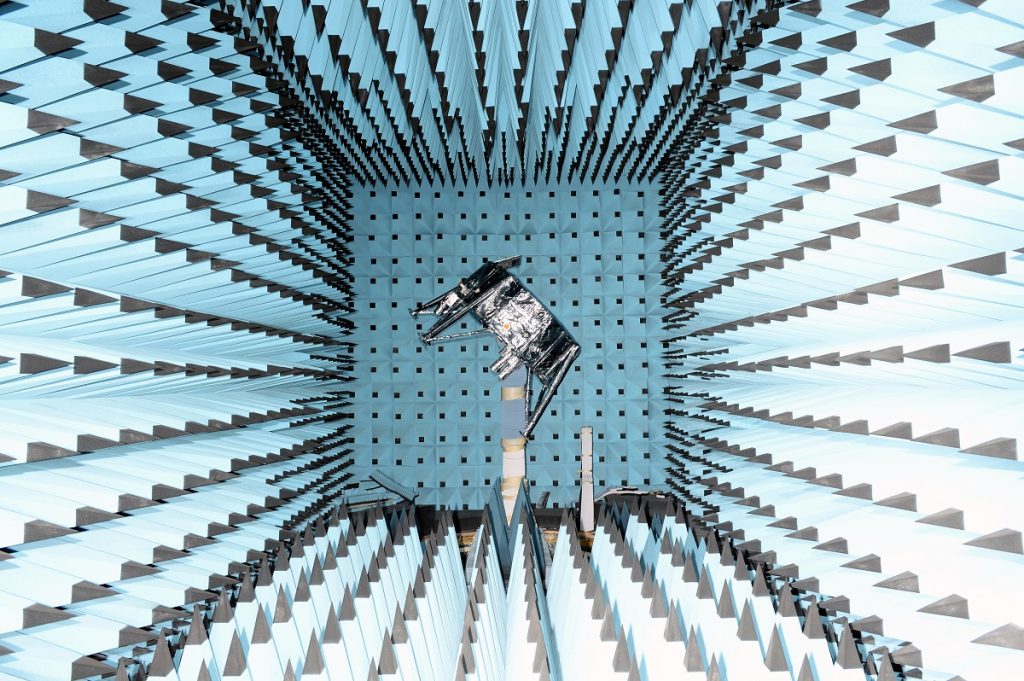The first Israeli spacecraft to be sent to the moon, Beresheet, will be launched in the early hours (Israel time) of February 22, 2019 from Cape Canaveral Kennedy Space Center in Florida, SpaceIL and Israel Aerospace Industries (IAI) announced at a press conference in Ramat Gan on Monday. At the event, the representatives detailed the chutzpah, big dreams, and ingenuity behind the project that has the space community in Israel and abroad in a frenzy.
If all goes according to plan, the Israeli spacecraft bearing the national flag will make space history on April 11, 2019, when Beresheet is scheduled to land on the moon.
“Eight years ago, we ventured on this journey that is now nearing completion in about two months when we land on the moon,” said South African-Israeli philanthropist Morris Kahn, the president of SpaceIL.
“We are making history and are proud to be part of a group that dreamed and realized the vision that many countries in the world share, but so far only three have realized,” he added at the press conference.
When Beresheet touches down on the moon, Israel will become only the fourth country to achieve a soft landing on the lunar landscape, after the US, the former Soviet Union, and China. And while the other missions cost billions of dollars, the SpaceIL project cost $100 million, mostly privately funded and with minimal input from the state. That figure, says SpaceIL CEO Dr. Ido Anteby, is “tens of millions of dollars cheaper than other space missions.”
Kahn, who donated $40 million to SpaceIL, hailed the project as “an example of Israeli ingenuity,” and Israeli President Reuven Rivlin declared the mission a national project.
“I am delighted and proud that you decided to turn this project into not just a wonderful technological achievement, but also an educational undertaking. You are an example of groundbreaking, audacious Israeli innovation,” Rivlin said on Sunday when meeting with SpaceIL and IAI representatives.
“I couldn’t be prouder than to give this gift to the people of Israel and make it part of the Israeli ethos of technology, daring and a generous dose of nerve,” said Kahn.
Indeed, the SpaceIL initiative is a proud moment for Israeli space sciences. It also highlights Israel’s trademark of making the seemingly impossible possible.
The unmanned spacecraft, packed with local blue-and-white technologies, is brimming with firsts.

When it launches between Thursday and Friday at around 03:45 a.m. Israel time (East coast time 21/2/19 around 20:45pm), it will mark the first time a spacecraft piggybacks to enter Earth’s orbit as SpaceIL will grab a rideshare on a SpaceX Falcon rocket.
Beresheet is also the first lunar lander that is a private initiative, rather than a governmental project. It is the smallest spacecraft by heft, weighing just 600 kilograms with full fuel tanks and upon landing an approximate 180 kilograms. Its measurements run two meters in diameter and 1.5 meters tall when standing on its four folding legs.
And because of its small size, the spacecraft will log the longest journey – 6.5 million kilometers – as it orbits around Earth until landing on the moon. The craft’s fuel tanks are tiny in order to keep its size compact and thus must use orbits to reach the moon instead of flying in a more direct path.
“How much chutzpah is it to get to the moon? It’s a huge amount of chutzpah whichever way you look at it. I’m not sure chutzpah wouldn’t have been a better name than Beresheet for the spacecraft,” joked Opher Doron, IAI’s Space Division General Manager.
Sign up for our free weekly newsletter
SubscribeIt was the audacity and daring of three young engineers that even made this mission a possibility.
“It feels like a dream, it’s really an exciting moment,” Yonatan Winetraub, a co-founder of SpaceIL, said at the press conference.
Winetraub, together with entrepreneurs Yariv Bash and Kfir Damari came up with the idea to put an Israeli spacecraft on the moon over drinks at a pub in a city on the outskirts of Tel Aviv in 2011. The three enrolled in Google Lunar XPRIZE Challenge, a competition that ended without a winner in March 2018.
When Google announced it was ending its challenge, SpaceIL vowed to continue working on its mission. After all, it was never toward the $20 million purse that the SpaceIL founders geared.
SpaceIL’s founders have always had two main goals: to land an Israeli spacecraft on the moon, and to inspire the younger generation to study science and technology.
“The common goal [of everyone working on this project] is to put the spacecraft, which has an Israeli flag on it, on the moon,” Anteby told NoCamels.
The mission also puts Israeli engineering knowledge and advanced development capabilities in the global spotlight.
“The three founders, their vision, their chutzpah and their audacity gave us, all the engineers and everyone who took part in this project, an amazing present. An amazing engineering adventure,” said Anteby.
“It was very exciting to work with SpaceIL on this project and also interesting from an engineering point of view. This was an inspiration,” Inbal Kreiss, Deputy General Manager, Space Division, IAI, tells NoCamels.
SEE ALSO: SpaceIL’s First Israeli Spacecraft Arrives In Florida Ahead Of Moon Launch
At the press conference, SpaceIL and IAI representatives reiterated how this mission began as an idea from three young engineers in 2011, grew into a national dream and is now holding the hopes of the international space community for the future of space travel.
Anteby said global space agencies see SpaceIL as “the prototype of a commercial spacecraft with the ability to reach the moon.”
This is not only “the future of the Israeli spacecraft industry,” he said. “The world is looking at us because it is clear to everyone that a successful SpaceIL mission will open a new horizon to the global space industry for future commercial spacecraft ventures.”
Viva Sarah Press is a journalist and speaker. She writes and talks about the creativity and innovation taking place in Israel and beyond. www.vivaspress.com
Related posts

Editors’ & Readers’ Choice: 10 Favorite NoCamels Articles

Forward Facing: What Does The Future Hold For Israeli High-Tech?

Impact Innovation: Israeli Startups That Could Shape Our Future






Facebook comments